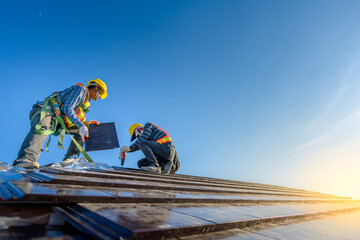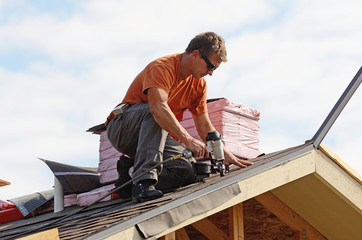The Importance of Roof Repair
The roof is one of the most important parts of a home, protecting it against the elements. It should be inspected regularly by a professional.
After a storm, check the shingles, tiles, or flashing (the thin sheet metal around pipes and skylights) to see if they’ve peeled, shifted, or dislodged.
Your roof will withstand years of rain, sleet and snow, but it won’t last forever. Neglect and wear will eventually take their toll, resulting in leaks, decay, and other problems. The best way to keep your roof in tip-top shape is to catch and address problems as they emerge – or even before they occur.
The most obvious signs of trouble are leaking, shingle damage and the presence of mold or mildew. If you notice any of these, or other water stains or drips in the house, it’s time for an emergency roof repair.
Leaks typically begin at points where the roof meets other structures, such as skylights, chimneys or roof windows. These areas are especially vulnerable to moisture because they create a “valley” where two different slopes of the roof meet. During heavy rainfalls, this valley can collect debris and water and cause the interior of your home to flood.
If you have access to your attic, soaking targeted spots of the ceiling with a garden hose will help you locate the source of the leak. You can also check for wet insulation or stained sheathing, which will give you clues as to where the leak is coming from. For example, if the stain is in a certain area of the ceiling, you might need to remove a small section of drywall to find where the water is collecting and wicking down.
Other common leak sources include the eaves, dormers and walls. In these areas, check for rotten or corroded caulk and apply new sealant as needed.
Another important area to inspect is flashing, which protects creases on fixtures such as chimneys and roof windows and preserves venting pipes under roofing materials. Flashing can crack and tear, leaving these fixtures vulnerable to moisture and water. Regular inspections will make this type of damage easier to spot and fix.
A well-maintained roof will not only protect your house from the elements, but it will add value to your home, too. Taking the time to regularly inspect your roof and clear away debris will go a long way toward keeping it in good condition.
Choosing the Right Materials
Choosing the right roofing materials for a repair job isn’t just about aesthetics. The right material can help a roof stand up to wild weather, keep a home comfortable and save energy bills over time.
Before you decide what materials to use for a particular repair, it’s important to understand the type of damage that needs attention. This may include leaks, missing shingles or cracked flashing. In some cases, you might need to install a new ventilation system or gutters to channel water away from the house.
You can do a visual inspection of your roof to identify problems. In addition to leaks, you should check for rust spots, signs of wear like curling or discoloration and the presence of moss or algae. You should also take note of any sagging areas, which could indicate a structural problem that needs professional attention.
A variety of different materials are available for your home’s roof, including asphalt shingles, clay or concrete tiles and metal. Each has its advantages and disadvantages. For example, shingles are durable and affordable, but they tend to lose their color over time, which can lead to the appearance of a faded roof. Clay or concrete tiles are longer-lasting, but they’re more expensive and require professional installation. Metal roofs can be costly but are durable and fireproof. They’re also effective at reflecting heat, which helps reduce cooling costs.
If you need to replace damaged shingles, it’s important to choose replacements that match the originals. Otherwise, you might end up with a patchwork look that’s less attractive and could contribute to future leaks. In addition, you’ll need to have the correct tools for the job, including a ladder that’s safe to climb and the right safety equipment.
Another consideration is the climate in your area. Some materials, such as terracotta and concrete tiles and copper, work best in warm or dry environments. Others, like metal and shingle roofs, are more suitable for colder climates, as they shrug off snow effectively.
Getting the Job Done
When it comes to roof repair, the most important thing is to know what needs fixing and the extent of the damage. That’s why any experienced roofing contractor, electrician or plumber will tell you that before you can set to work addressing an issue, it’s critical to get to the bottom of it.
As any homeowner knows, the quiet moments after a storm can be the most terrifying. If hail, strong winds or a falling tree have damaged your roof, questions swirl. Who do you call first? How long will it take for the insurance company to respond? Will the weather cause further damage if you don’t do something quickly?
A professional roofer will have experience in these types of situations and can help you navigate the insurance process. They will also be equipped with the proper safety equipment and have a thorough understanding of the best practices for working on complex repairs. A professional roofer will also be able to provide you with detailed quotes, cost estimates and any applicable warranties and guarantees for materials and workmanship.
While you’re waiting for the insurance company to complete their assessment, make sure that any leaking areas are covered with tarps and any dents or cracks are sealed. You should also regularly check for any low-hanging limbs that could be at risk of breaking off and causing further damage.
Lastly, if you have pets, consider having them stay at a friend’s house or with a pet sitter during the repair work. The hammering noise and strangers in and out of the house can be upsetting for dogs, cats, hamsters and other household pets. And they may be in danger of stepping on any stray nails or other debris as well.
Finally, be sure to look for local or state rebates on energy efficient roofing, and any other repairs that would improve the overall efficiency of your home or business. This is a great way to reduce the cost of some of the most common and costly repairs.
Preventing Future Damage
A good roof is crucial for safeguarding the rest of your home. Without one, the underlying materials would quickly become damaged by weather and daily wear and tear. A well-maintained roof will keep those materials undamaged and protected, protecting your finances, your health and your family.
The best way to protect your roof from damage is to prevent it before it occurs. This can be done by routinely checking and maintaining your roof, and by identifying signs of trouble. If you notice any damage, it’s important to take immediate action. This may involve assessing the damage, temporarily securing the area, and contacting a professional roofing contractor.
Checking your roof regularly is the best way to identify problems and address them before they can lead to extensive water damage. Look for obvious issues, such as missing or damaged shingles, sagging areas, and leaks. It’s also a good idea to check the flashing around chimneys, roof windows, and vents for signs of damage or deterioration. You should also regularly inspect the gutters for blockages and debris that could cause drainage issues.
When a storm does hit, it’s important to take quick action to minimize further damage. This may involve assessing the damage and securing the area with temporary solutions, such as tarping. You should also notify your insurance company promptly and follow their instructions for filing a claim.
If you are looking for a roofing contractor to repair your roof after a storm, be sure to choose a local contractor with a reputation for reliable, long-term support. A reputable local contractor will have a vested interest in the community and offer ongoing support, ensuring that any repairs are completed correctly and that any questions or concerns are addressed in a timely manner.



